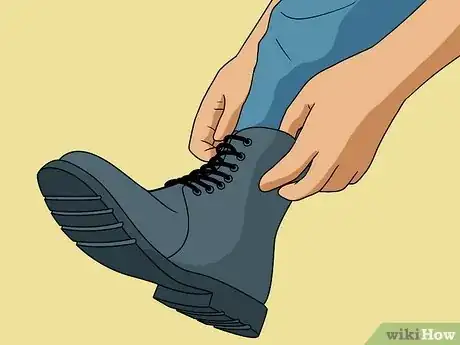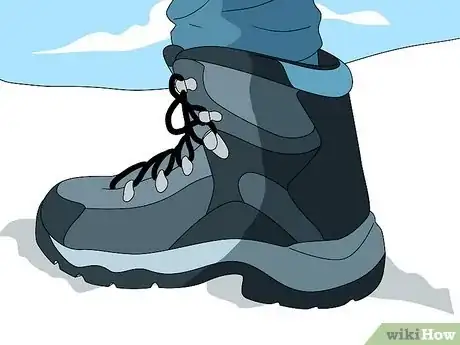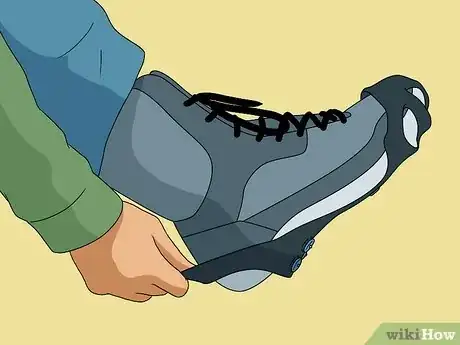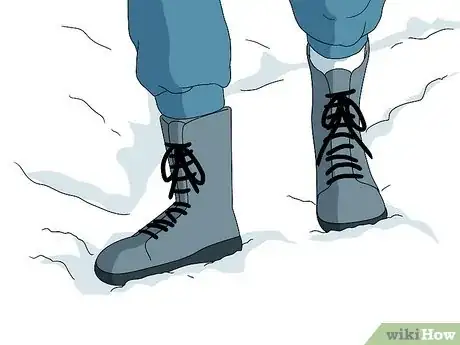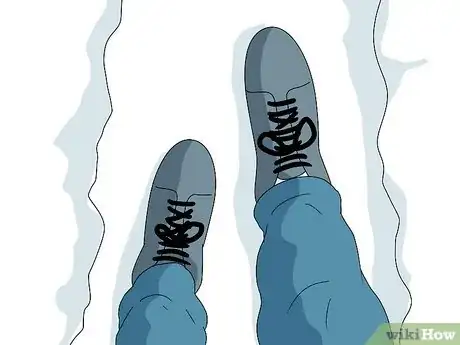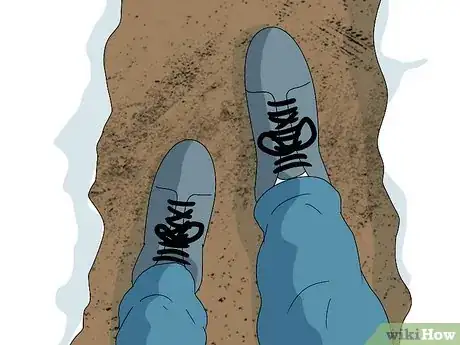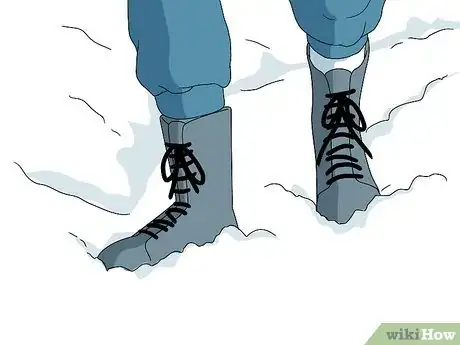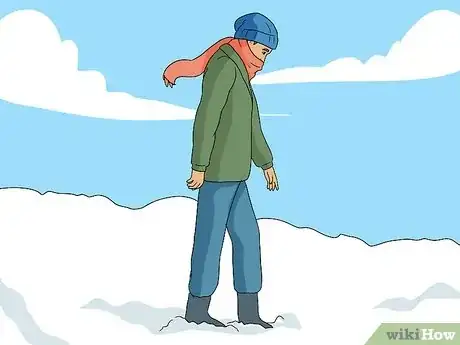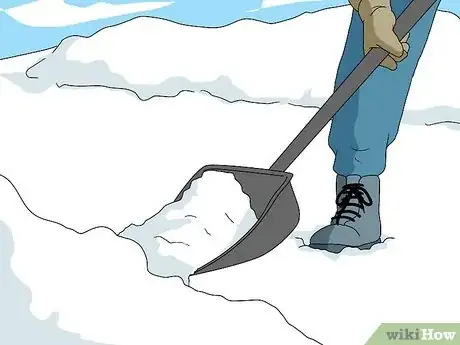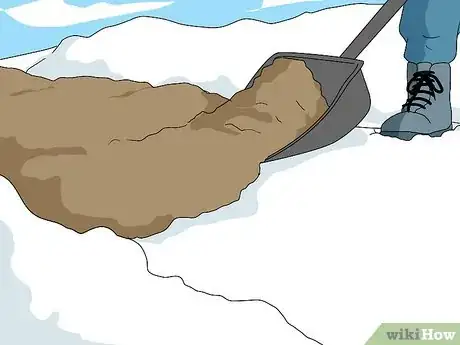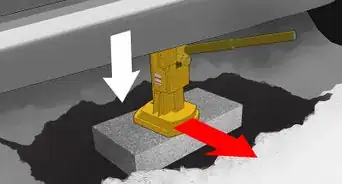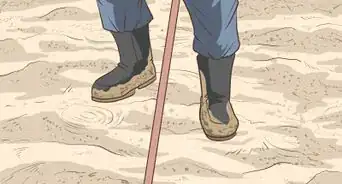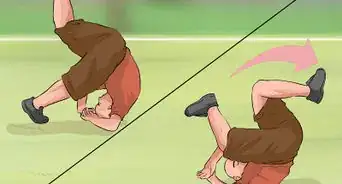This article was co-authored by High Mountain Institute. The High Mountain Institute is an educational organization dedicated to helping students connect with nature, develop as leaders, and discover education at its best. For over 25 years, HMI has taken students into the wilderness of Colorado and Patagonia and fostered communities of shared responsibility, thereby creating the foundation for rigorous intellectual experiences.
This article has been viewed 63,746 times.
Walking in the snow can be a treacherous task. Nothing is worse than taking an embarrassing slip on the ice and having people laugh or giggle at your misfortune. Not only does it hurt your ego but it can also injure your body as well. This awkward situation is avoidable, however, if you prepare well for an outing on slippery surfaces and you move properly while walking in the snow.
Steps
Wearing the Correct Footwear
-
1Wear shoes or boots with traction. Nothing is worse than wearing footwear without grip while walking in the snow. It will send you sliding in no time. Instead, pick sneakers or boots that have lots of traction. If the soles have treads with deep grooves then they are less likely to slip when you take a step.
- Avoid wearing unstable shoes or any sort of shoe with no tread while walking in the snow. Wearing sensible shoes in the snow will help you tremendously.
- Of course, shoes designed to be worn in snow are probably the best choice. They should have great traction for snow, as well as usually being waterproof.
-
2Get shoes or boots with ankle support. Having ankle support can help you avoid a slip. Supporting your ankles allows you to have more stability when your feet start to go, especially if you have weak ankles to begin with. Ankle support may also help you to avoid an ankle injury if you do indeed fall.
- Without ankle support you are more likely to get an ankle strain if you fall, especially if you have injured your ankles before.[1] You may try to use your ankles to steady yourself if you begin to slip and this can injure an unsteady ankle.
Advertisement -
3Add additional grip to your shoes. If you will be doing a lot of walking in the snow, and you are less than thrilled with the amount of grip your shoes are giving, then add some traction to them. You can buy removable ice grips that you can add to any shoe or boot. They can usually be put on and taken off easily and will increase your stability immensely.[2]
- If you are in a pinch, place a plastic bag or sock over your footwear. This will increase the grip significantly.
-
4Knock the snow off your footwear. Whatever kind of shoes you pick, be sure to knock the snow off of them when you get a chance. This will clear the grooves on the sole and allow them to create traction again. Use any opportunity you can to stamp the snow off your footwear.
- Knocking the snow off your shoes will it prevent the ice from melting into your footwear, and it will give you that extra comfort when walking.
Walking in the Snow
-
1Take your time. It's important not to rush when you are walking in the snow. Even if you are late or trying to get somewhere quickly, be calm and step slowly. If you do try to rush your steps, you might be arriving late anyhow because you got an injury.
- Walk with short and cautious steps to avoid slipping.
-
2Keep your weight leaning slightly forward on the insides of your feet. This means that you will be walking a little bit like a penguin. This position will be more stable when attempting to move across a slippery surface.
- If you do fall while walking in this position, you are more likely to fall forward rather than backward.
-
3Walk on the grit! If you have the option of walking on a more stable surface than you should. Sidewalks covered in sand or litter will help you walk more easily and you may even be able to pick up your pace.
- Remember that a sidewalk with grit on it is not slip proof! While you may be able to walk a bit quicker, don't abandon caution altogether. You may just hit a slippery spot and have your feet slid right out from underneath you.
-
4Avoid walking on highly compacted snow. Walk near the edges of the sidewalk where few have walked already. Compacted snow can quickly turn into ice, which is much more slippery. Instead, walk in the snow that is still fluffy and less slippery.
- You may get snow all over your shoes when walking in the deeper snow but that is better than slipping and falling.
-
5Concentrate on walking. Pay attention to where you are going and don't get sidetracked from focusing on your steps. Try to think a few steps ahead and plan your next movements before you do them. This will help you to pick the best route and avoid particularly slippery areas.
- Be sure not to bump into other people around you because you are concentrating on your steps so much. You need to be aware of your surroundings, in addition to being cautious with your steps.
Removing Snow
-
1Shovel your walk. The best way to avoid slipping in snow is to avoid walking in it in the first place. Thus, if you don't want to slip in the snow in from of your home, then spend the time to remove it. Shoveling snow can be a hard job that takes a lot of energy but it is worth the work if you can avoid falling, or having someone else fall, in front of your home.
- Be sure to prepare well for snow shoveling before you do it. Get a good snow shovel that will help you move snow effectively and get a good stretch in before exerting yourself. Stretching before shoveling snow will help you avoid injury from the hard work.[3]
-
2Lay down grit. Sometimes after shoveling there is still a frozen layer that can be very slippery. This is especially the case if the remaining snow melts a little and then refreezes into a sheet of ice. In order to avoid slipping on this ice, put down a layer of grit after you shovel. This will assure that when you walk in the area you don't slip.
- The grit you lay down can vary. Some people use a small gravel or sand, while others use kitty litter to give the walk traction.[4]
-
3Put out ice melt. If you want your walk to be completely free of ice and snow you can put an ice melting product on it. You can either use salt or a manufacturer ice-melting product. These products are made of chemicals that lower the freezing point of water, in essence melting all snow it comes into contact with.
- Ice melting products can usually be found at your local home improvement store.
- Be sure to look for any warnings on the packaging of an ice melt product you are considering using. There may be warnings about what surfaces they can be applied to and what to avoid getting the product on.
- In addition to melting ice, salt can severely damage, or kill, plants and wildlife. Be sure to use it sparingly if you are concerned about the health of plants and animals near your walk. In fact, some cities have outlawed the use of salt in order to protect wildlife.[5]
Community Q&A
-
QuestionIs it truth or myth that I can prevent slips when initially stepping outdoors if I pause to let the soles of my shoes cool down to surface temperature?
 Tom De BackerTop AnswererMyth. Slipping depends on grip, which deteriorates with cold. A flexible, studded sole will have snow stick to it, whether it's cold or not. Winter shoes are designed with snow in mind and here, too, it doesn't matter if they're cold or not. So no, pausing to let your soles cool down does not do anything but waste your time.
Tom De BackerTop AnswererMyth. Slipping depends on grip, which deteriorates with cold. A flexible, studded sole will have snow stick to it, whether it's cold or not. Winter shoes are designed with snow in mind and here, too, it doesn't matter if they're cold or not. So no, pausing to let your soles cool down does not do anything but waste your time. -
QuestionWhat if I don't have ice melt and am not prepared for the winter?
 Community AnswerJust be cautious about how fast you are going, and watch where you are stepping. Also try to avoid areas with a lot of ice.
Community AnswerJust be cautious about how fast you are going, and watch where you are stepping. Also try to avoid areas with a lot of ice.
Warnings
- Try not to run unless you're in an area with absolutely no ice or snow on it.⧼thumbs_response⧽
References
- ↑ http://www.ncbi.nlm.nih.gov/pubmedhealth/PMH0072736/
- ↑ http://fashionista.com/2014/12/mynxx-ice-grips
- ↑ http://www.bobvila.com/articles/shoveling-snow-tips/#.VvyVs8cleRs
- ↑ http://www.bobvila.com/articles/salt-vs-sand/#.VvyW1scleRs
- ↑ https://www.redfin.com/blog/2013/10/6-tips-to-prepare-your-home-for-winter-ice-storms.html
